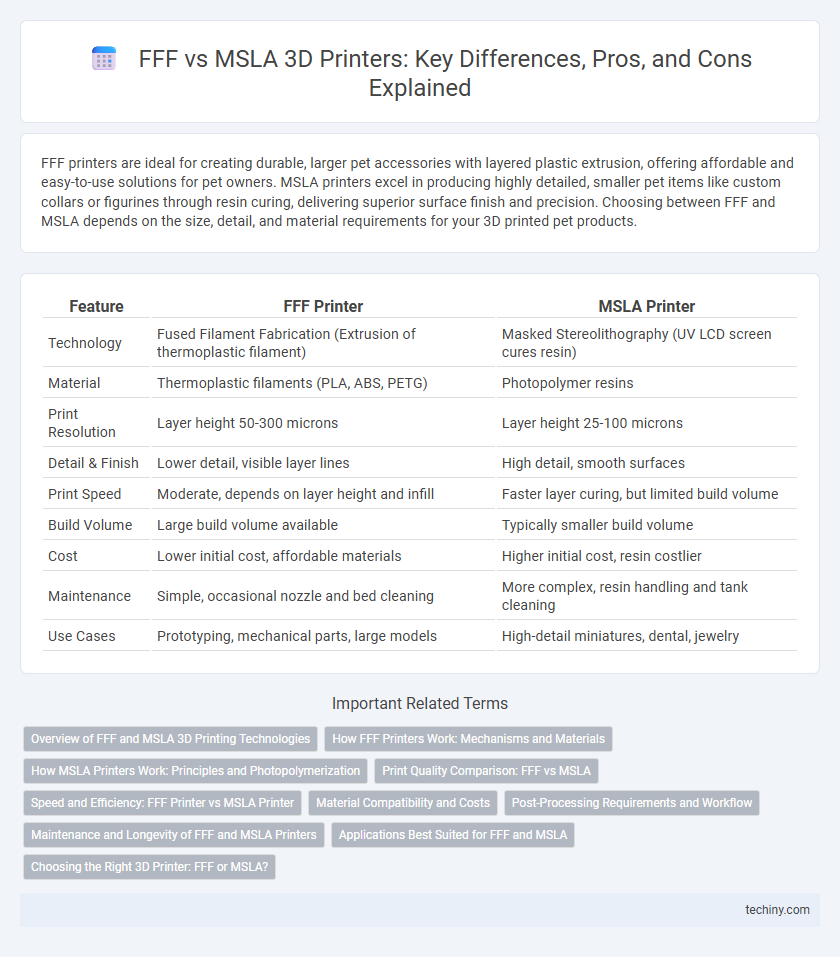FFF printers are ideal for creating durable, larger pet accessories with layered plastic extrusion, offering affordable and easy-to-use solutions for pet owners. MSLA printers excel in producing highly detailed, smaller pet items like custom collars or figurines through resin curing, delivering superior surface finish and precision. Choosing between FFF and MSLA depends on the size, detail, and material requirements for your 3D printed pet products.
Table of Comparison
| Feature | FFF Printer | MSLA Printer |
|---|---|---|
| Technology | Fused Filament Fabrication (Extrusion of thermoplastic filament) | Masked Stereolithography (UV LCD screen cures resin) |
| Material | Thermoplastic filaments (PLA, ABS, PETG) | Photopolymer resins |
| Print Resolution | Layer height 50-300 microns | Layer height 25-100 microns |
| Detail & Finish | Lower detail, visible layer lines | High detail, smooth surfaces |
| Print Speed | Moderate, depends on layer height and infill | Faster layer curing, but limited build volume |
| Build Volume | Large build volume available | Typically smaller build volume |
| Cost | Lower initial cost, affordable materials | Higher initial cost, resin costlier |
| Maintenance | Simple, occasional nozzle and bed cleaning | More complex, resin handling and tank cleaning |
| Use Cases | Prototyping, mechanical parts, large models | High-detail miniatures, dental, jewelry |
Overview of FFF and MSLA 3D Printing Technologies
FFF (Fused Filament Fabrication) printers operate by extruding thermoplastic filaments layer by layer to create objects, offering affordability and ease of use for prototyping and functional parts. MSLA (Masked Stereolithography) printers utilize UV light to cure photosensitive resin with a masked LCD screen, producing high-resolution, detailed prints ideal for intricate designs and smooth surface finishes. While FFF excels in material variety and larger build volumes, MSLA is favored for precision and fine detail in smaller scale prints.
How FFF Printers Work: Mechanisms and Materials
FFF printers operate by extruding thermoplastic filament through a heated nozzle, depositing layers that fuse upon cooling to form solid objects. The mechanism relies on precise control of the print head movement along X, Y, and Z axes, combined with controlled filament extrusion to achieve detailed layer-by-layer construction. Common materials used in FFF printing include PLA, ABS, PETG, and TPU, each offering varying mechanical properties suitable for prototypes, functional parts, and durable models.
How MSLA Printers Work: Principles and Photopolymerization
MSLA printers utilize masked stereolithography technology, employing an LCD screen to selectively cure photopolymer resin layer by layer through UV light exposure. This precise photopolymerization process solidifies resin only in designated areas, enabling high-resolution prints with smooth surface finishes. The method contrasts with FFF printers by achieving greater detail and faster curing times due to its light-based polymerization rather than filament extrusion.
Print Quality Comparison: FFF vs MSLA
FFF printers typically produce models with visible layer lines and lower resolution due to the extrusion process and nozzle size limitations. MSLA printers achieve higher print quality with finer details and smoother surfaces by curing resin with precise UV light patterns. The enhanced resolution of MSLA technology results in superior accuracy, making it ideal for intricate designs and professional applications.
Speed and Efficiency: FFF Printer vs MSLA Printer
FFF printers typically offer slower print speeds due to the layer-by-layer extrusion process, which requires precise nozzle movements and controlled cooling times. MSLA printers leverage masked LCD technology to cure entire layers simultaneously, resulting in significantly faster print times and higher efficiency for complex, detailed models. The efficiency gains in MSLA printers also reduce material waste and energy consumption compared to the more mechanical and time-intensive FFF printing process.
Material Compatibility and Costs
FFF printers use thermoplastic filaments like PLA, ABS, and PETG, offering a broad range of affordable and widely available materials. MSLA printers rely on photosensitive resins that provide high-resolution details but come with higher material costs and limited resin types. Overall, FFF printers deliver cost-effective versatility, while MSLA excels in precision but requires investment in specialized, more expensive consumables.
Post-Processing Requirements and Workflow
FFF printers demand extensive post-processing involving support removal, sanding, and sometimes chemical smoothing to achieve a refined surface finish, extending the overall workflow time. MSLA printers require less mechanical post-processing but need careful resin cleaning, UV curing, and handling of toxic materials, which necessitates safety precautions and dedicated workspace management. Workflow efficiency varies as FFF post-processing is labor-intensive and MSLA emphasizes chemical and curing steps, influencing choice based on operator skill and production environment.
Maintenance and Longevity of FFF and MSLA Printers
FFF printers require regular maintenance such as nozzle cleaning, bed leveling, and filament replacement to ensure consistent print quality and prolong lifespan. MSLA printers necessitate careful resin handling, periodic LCD screen replacement, and tank cleaning to maintain print accuracy and extend durability. Both technologies benefit from timely upkeep, but MSLA printers typically demand more frequent component replacements due to resin exposure and UV light wear.
Applications Best Suited for FFF and MSLA
FFF printers excel in producing large, durable prototypes, functional parts, and mechanical components due to their ability to use a wide range of thermoplastics like PLA, ABS, and PETG. MSLA printers are best suited for high-detail applications such as dental models, jewelry casting, and intricate miniatures, leveraging photopolymer resins for superior surface finish and precision. Industries like automotive and engineering often opt for FFF technology for robust parts, while healthcare and manufacturing sectors prefer MSLA for detailed, small-scale production.
Choosing the Right 3D Printer: FFF or MSLA?
Choosing the right 3D printer depends on your project requirements: FFF printers excel in producing durable, large-scale parts using thermoplastic filaments, while MSLA printers deliver high-resolution, intricate details perfect for miniatures and prototypes with photopolymer resins. FFF technology offers affordability and versatility for functional components, whereas MSLA provides superior surface finish and precision for detailed models. Evaluate factors such as print resolution, material compatibility, build volume, and post-processing needs to determine whether FFF or MSLA aligns best with your creative and functional goals.
FFF Printer vs MSLA Printer Infographic

 techiny.com
techiny.com